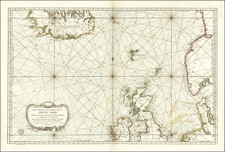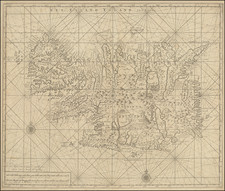Rare Early Map of Iceland
Finely colored example of the Carolus map of Iceland, first publishce by Jodocus Hondius in the first half of the 17th century. This is a stunning map, including an erupting volcano, sea monsters, sailing ships, decorative cartouches, compass rose, and the spectacular landscape of Iceland.
Originally published by Jodocus Hondius, this map updates the earlier Mercator map of the island which had become overused. The map credits Joris Carolos, who had personally visited Iceland, as its source, though it seems that Blaeu also reused a number of toponyms from the earlier Ortelius map. The map includes a number of new islands and fords, some of which are fictional, although little change appears in the interior of the island.
The motivation for the creation of this map appeared to be to create something new for consumers who were tired of the repetitive appearance of the same two maps. However, this quest for newness apparently did little for accuracy (Gretarsson).
Pitt was from Cornwall, where he was baptized at St. Teath in 1639. He was educated locally but moved to London when apprenticed to bookseller Robert Littlebury. At the end of his apprenticeship, in 1661, he was made free of the Haberdasher’s Company. His first books to be published with his own imprint appeared in 1667.
Pitt specialized in learned publications and imported scholarly works from continental Europe. He also published the writings of members of the newly formed Royal Society, including Robert Boyle, as well as high-ranking clergymen. In 1678, Pitt was the first bookseller to offer his wares via an auction.
Thanks in part to his ties to the Royal Society, Pitt announced in 1678 that he would publish a massive twelve-volume atlas of the world. The plates were to be based on Dutch maps, with a text written by Bishop William Nicholson and Richard Peers. However, only four volumes ever appeared.
Pitt, who was also managing several properties in Westminster and had expanded in a partnership to Oxford, was spread too thin. The cost of each volume of the atlas alone Pitt estimated at £1,000. One by one, his ventures turned foul, landing him in debtors’ prison for seven years. He died in London, but not in prison, in 1697.









![[ Iceland ] Tabula Islandiae Auctore Georgio Carolo Flandro](https://storage.googleapis.com/raremaps/img/small/91305.jpg)




